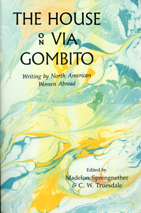Reading about Venice, before going for a visit, I discover in Jan Morris’ book (named for the city) that the Venetians have a dialect distinctly their own. Not only do they elide standard Italian–removing the ll’s in bello to become beo, but they substitute their own words for the usual: fork is not forchetta but piron. A watch is relozo, not orologio. One of the reasons I return again and again to Italy is my love of the language: if I don’t rev up my memory (listening to language tapes) and then speak Italian for a week or so, it declines, maybe never to be heard again. But what about a place where “my” Italian is forestalled by ancient, sly alterations? I promise a report.
There are the dialects within our own country. Charleston, South Carolina, where I grew up–a Yankee pomodoro (tomato) within the Southern peaches–has its peculiar speech, drawling its charming (and like Venice facing the sea) somewhat self-satisfied way through languid heat and short winter chill. As a girl, I could hear the whites’ drawl and discover meaning in it, but when the black people of the city talked, I was completely cut off. Later I did some research on Gullah, the creole originating on the sea islands off the coast of South Carolina and Georgia, and discovered it’s a combination of the African language(s) spoken by the enslaved African peoples and the English spoken by 18th century white Charlestonians.
Charleston was one of the largest ports of colonial settlement: in fact. Wikipedia thinks that half of the African-Americans who trace their ancestry to slavery, came through Charleston. Many of them had a sojourn first in Brazil, then the Bahamas or Barbados. These skilled rice growers (from rice-growing parts of Africa) helped Charleston planters create extensive rice cultivation, on large, remote plantations where the white population was very small compared to the black. Not surprisingly some West African traditions took root: like the “shouts” or dance/sing/cry out religious celebrations which became part of local churches. I remember listening to recordings made by Alan Lomax of these shouts. Vivid, heart-pounding, hard to resist.
The wonderful anthology, Black-Eyed Susans, Midnight Birds, edited by Mary Helen Washington in 1990, contains a long story by Sherley Anne Williams, “Meditations on History,” in which a pregnant slave, who’s part of an insurrection on a trading coffle, escapes her white captors through communicating with “maroons” or tiny communities of escaped slaves. Her communication is entirely through song/lament/calls–all blended with Christian hymns, but having the stamp of the African shout.
We in Minnesota have so little experience with this part of American history (as do, in fact, many many other white Americans) that we either never consider this current of language and culture among us or pooh-pooh its important. In fact, I’d venture to guess that most African-Americans living in the U.S. today are bi or tri-lingual, speaking a creole among themselves, and a version of “standard” American English to whites. Obviously there will be cross-overs, bits of speech that enter their “standard” English from the creole. When the English teacher in me corrects these cross-overs, I try to remind myself of my own on-going attempts to speak Italian wherever I visit Italy. Venice will probably offer the biggest linguistic challenge I’ve encountered, though the Florentine dialect has thrown me for a loop more than once. The minute I step off the trade, hotel and museum routes and attempt conversation with a Florentine native, I’m stymied. I’m preparing myself to be soon stymied in Venice!
And why do these pockets of specialized speech persist? In Italy, which resisted unification for centuries and even now has trouble acting as a unified country (we in the U.S. are taking lessons there), the local dialects signified belonging–them and us, outsiders and insiders, those we trust and those we don’t. Despite being a relatively small country in area, Italy stretches from the Alps to almost touch Africa. TV and other kinds of mass communication change the persistence of local orientations, yet I bet more Minnesotans have read the poetry of the recent Nobel-prize-winning Swedish poet, Transtromer, than have Charlestonians. Minnesota is peopled by Swedes, Norwegians, Germans. I notice that the king and queen of Norway are now here for a visit. Those of us who grew up elsewhere may come to appreciate local specialities, but we’ll never quite assimilate like those who can trace ancestors back two or three generations. I’m not complaining, only commenting, with the hope of showing that lots of other places in the world have their specialized speech and tight-knit insider groups.


Leave a Reply